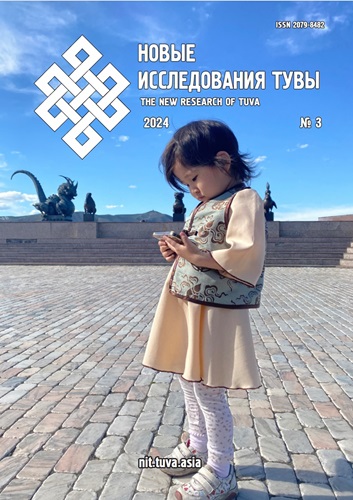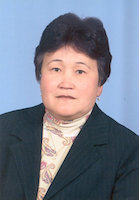The structures of representations of the Tuvan language and Tuvan culture in the Russian-speaking picture of the world of young Tuvans
DOI:
https://doi.org/10.25178/nit.2024.3.12Keywords:
Tuvan language; Tuvan culture; Tuva; Tuvans; representation of language; representation of culture; structure of representation; social representationAbstract
The article presents an analysis of the types of structures of representations of Tuvan language and culture in the daily lives of ethnic Tuvans. The authors identify central and peripheral elements in the structure and the degree of connectivity between them, as well as the presence of clusters of representations. The empirical part of the study was conducted at Tuvan State University in 2022 and 2024, involving more than 70 participants (ethnic Tuvans aged 18–30). The research used a comprehensive qualitative and quantitative approach to analyzing representations, including methods such as essays, questionnaires, and mathematical methods.
It has been revealed that the structures of the representations of the Tuvan language and culture have several significant differences. The field “Tuvan Culture” domain is well-structured, with a clear distinction between the core, center, and periphery, and all elements are connected. Structurally and semantically, hyponymy is the leading mechanism. The field “Tuvan Language” domain is a loosely organized, atomic structure, with metaphor and attributive evaluative constructions as the leading types of semantic connections. At the same time, Tuvan language and culture are in a sense in complementary functional distribution, as one of the main functions of Tuvan is to ensure communication between generations, preserving the Tuvans as an ethnic group, while the main function of culture is to maintain horizontal ties within society, preserving the Tuvans as a social group.
References
Bakhtikireeva, U. M. (2016) About translingualism and transculturation through the prism of a single linguistic biography. Sotsial'nye i gumanitarnye nauki na Dal'nem Vostoke, no. 2 (50), pp. 76–80. (In Russ.).
Bicheldei, K. A. (2001) Pharyngalization in the Tuvan language. Moscow, RUDN. 290 p. (In Russ.).
Borgoiakova, T. G. and Pokoiakova, K. A. (2022) Semantic zones of language perception in the context of national-Russian bilingualism in Southern Siberia. New Research of Tuva, no. 4, pp. 53–64 (In Russ.). DOI: https://doi.org/10.25178/nit.2022.4.4
Glukhova, N. N. and Glukhov, V. A. (2009) The value systems of the Finno-Ugric superethnos. Ioshkar-Ola, OOO «String». 275 p. (In Russ.).
Dyrkheeva, G. A. and Tsybenova, Ch. S. (2020) Language attitudes and language loyalty of minor language speakers under the conditions of national-Russian bilingualism: the case of Buryats and Tuvans. New Research of Tuva, no. 1, pp. 62–74. (In Russ.). DOI: https://doi.org/10.25178/nit.2020.1.5
Kaplunova, M. Ya. (2022) Assessment of local residents’ perception of the language situation in the Republic of Tuva (based on the findings of a 2021 field study)]. New Research of Tuva, no. 4, pp. 28–37. (In Russ.). DOI: https://doi.org/10.25178/nit.2022.4.2
Moskvicheva, S. A., Aleksandrova, O. I. and Ebzeeva, Yu. N. (2022) Folklore culturemes in the structure of cultural representations of Tuvan people. New Research of Tuva, no. 1, pp. 164–182. (In Russ.). DOI: https://www.doi.org/10.25178/nit.2022.1.11
Moskvicheva, S. A., Vio, A. and Zamaletdinov, R. R. (2023) Language representations and language attitudes in the Mishar dialect continuum. Russian Journal of Linguistics, vol. 27 (3), pp. 689–715. (In Russ.). DOI: https://doi.org/10.22363/2687-0088-34933
Moskvicheva, S. A., Aleksandrova, O. I. and Bruffarts, N. S. (2023) Conceptualization of ideas about Russian culture and the culture of Russia in the Russian language. Russian Language Studies, vol. 21, no. 4, pp. 440–456. (In Russ.). DOI: https://doi.org/10.22363/2618-8163-2023-21-4-440-456
Pharyngalization as a typological feature of phonological systems (based on the material of the Turkic languages of Southern Siberia) (2014) / I. Ya. Seliutina, N. S. Urtegeshev, T. R. Ryzhikova, I. D. Dambyra, S. V. Kechil-ool; ed. by N. N. Shirobokova. Novosibirsk, Omega Print. 312 p. (In Russ.).
Abric, J.-C. (1994) Pratiques sociales et représentations. Paris, PUF. 303 p.
Aracil, L. V. (1976) Conflit linguistique et normalisation linguistique dans l'Europe moderne. Cahiers de l’IRSCE : Série A. Études et documents de sociolinguistique (Tom 1). Perpignan, Centre Universitaire de Perpignan. 19 p.
Blanchet, P. (2016) Discriminations: combattre la glottophobie. Paris, Textuel. 191 p.
Boudreau, A. (2016) À l’ombre de la langue légitime. L’Acadie dans la francophonie. Paris, Classiques Garnier. 297 p.
Boyer, H. (ed.) (2010) Pour une épistémologie de la sociolinguistique : actes du colloque international de Montpellier, 10–12 décembre 2009. Limoges, Lambert-Lucas. 427 p.
Boyer, H. (2012) Singularité(s) de la sociolinguistique du domaine catalan. Un repérage épistémologique. Histoire. Épistémologie. Langage, vol. 34, pp. 29–41.
Colonna, R. (ed.). (2014) Les locuteurs et les langues : pouvoirs, non-pouvoirs et contre-pouvoirs. Lambert-Lucas. 376 p.
Costa, J. (2017) Faut-il se débarrasser des “idéologies linguistiques”? Langage & Société, no. 160–161, pp. 111–127.
Flament, C. (1997) Structure, dynamique et transformation des représentations sociales. In : Jodelet, D. (ed.) Les représentations sociales. 5ème édition. Paris, PUF. 449 p. Pp. 224–239.
Guimelli, C. (1994) Pratiques nouvelles, transformation des représentations sociales et Schèmes Cognitifs de Base. Dans: Guimelli, C. (ed) Structures et transformations des représentations sociales. Paris, Delachaux et Niestlé. 266 p. Pp. 171–198.
Jodelet, D. (1989) Les représentations sociales. Paris, P.U.F. 424 p.
Kerbrat-Orecchioni, C. (2006) L’Énonciation. De la subjectivité dans le langage. Paris, Armin Colin. 272 p.
Maurer, B. (2011) Méthodologie d’enquête pour une représentation graphique des composants de la représentation sociale d’une langue. Dans: Blanchet, P. et Chardenet, P. (eds.) Guide de recherche en didactique des langues et des cultures : une approche contextualisée. Paris, Édition des archives contemporaines. 523 p. Pp. 179–192.
Maurer, B. et Desrousseaux, P.-A. (2013) Représentations sociales des langues en situation multilingue. La méthode d’analyse combinée, nouvel outil d’enquête. Paris, Édition des archives contemporaines. 124 p.
Matthey, M. (dir.). (1997) Les Langues et leurs images. Neuchâtel, IRDP. 132 p.
Moliner, P., Rateau, P. et Cohen-Scali, V. (2002) Les représentations sociales. Pratique des études de terrain. Rennes, Presses Universitaires de Rennes. 230 p.
Rosch, E. (1978) Principles of Categorization. In: Rosch, E. and Lloyd, B. (eds.) Cognition and Categorization. Hilldale, New Jersey, Lawrence Erlbaum. 340 p. Pp. 27–48.
Strauss, A. and Corbin, J. (1998) Basics of Qualitative Research: Techniques and Procedures for Developing Grounded Theory. 2nd ed. SAGE Publication. 312 p.
Urdapilleta, D. L. and Lo Monaco, G. (2015) Free associations and social representations: some reflections on rank-frequency and importance-frequency methods. Quality & Quantity, vol. 49(2), pp. 489–507.
Vallverdú, F. (1977) La normalització del catalán modern. Treballs de sociolingüística catalana, no. 1, pp. 147–155.
Viaut, A. (2010) La notion de besoin linguistique et les langues minoritaires. Dans: Darbon, D., Otayek, R. et Sadran, P. Altérité et identité, itinéraires croisés. Mélanges offerts à Christian Coulon. Bruxelles, Bruylant. 418 p. Pp. 401–416.
Published
How to Cite
For citation:
Moskvicheva S. A., Suvandii N. D. and Alexandrova O. A. The structures of representations of the Tuvan language and Tuvan culture in the Russian-speaking picture of the world of young Tuvans. New Research of Tuva, 2024, no. 3, pp. 203-225 (In Russ.). DOI: https://doi.org/10.25178/nit.2024.3.12
Issue
Section

This work is licensed under a Creative Commons Attribution-NonCommercial 4.0 International License.

Author(s) license holder(s) grant rights for their work to the journal (grantee of a license) under the simple non-exclusive open license in accordance with Art. 1286.1 «Open license for a research work, work of literature or fine arts», Civil Code of the Russian Federation.
New Research of Tuva publishes articles under the Creative Commons Attribution-NonCommercial license (CC BY-NC).
Since it is an open license, author(s) reserve the right to upload the article to their institutional repository, submit it to another journal (if it allows republications), or republish it on their own website (in full, or in part).
However, several conditions apply here:
a) The republished version must always contain the name(s) and affiliation(s) of the author(s), the original title and the hyperlink to the original version on the New Research of Tuva website;
b) It must be in open access, free of charge, and no category of readers must be in any way whatsoever advantaged over general readership.
c) should the contribution be submitted elsewhere by its author(s) without substantial modification (30% or more of original text unchanged), the body of the article should contain a disclaimer that the original version was published in New Research of Tuva (with a link to the respective page)
The CC-BY-NC is a non-revocable license which applies worldwide and lasts for the duration of the work’s copyright.











